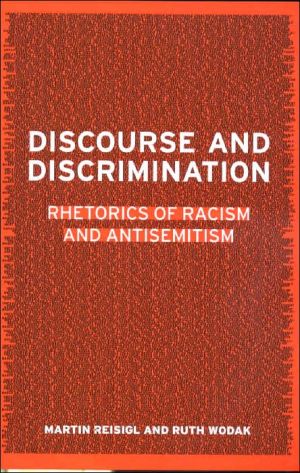

 |

|

The average rating for Discourse and Discrimination: Rhetorics of Racism and Antisemitism based on 2 reviews is 4.5 stars.
Review # 1 was written on 2017-08-13 00:00:00 Jane Davis Jane DavisThis is an interesting and well-researched discussion of the ways in which Bohemian nobility of the late 18th and early 19th centuries involved themselves in intellectual pursuits that would eventually help shape the 19th-century Czech nationalist movement. I found the title of the book mildly misleading--while it is not off base, in my opinion it overemphasizes focus on Czech versus German, which as the text rightly shows was not a major issue for the nobility in the 18th century and only gradually became significant during the 19th. However, I quite enjoyed Krueger's examination of the effects of the Enlightenment and the ways in which scientific and intellectual pursuits enabled the nobility and men of lower birth to meet on a common ground. |
Review # 2 was written on 2016-12-01 00:00:00 Andy Hayworth Andy HayworthThis book provides a concise overview of the history of conflict in Croatia, as well as broader conflicts in the Croatian region from a Croatian perspective. Marcus Tanner adopts a descriptive approach in this book, seeking to weave a narrative discussing the political and military intrigue in the country from the time that the ancestors of modern Croatians first migrated to the region in the 7th century. The book is divided into twenty chapters, the first of which describes the control of the region by the Byzantines and Franks, and the conversion of the region to Christianity. The following three chapters analyze the manner in which the Hungarians came to dominate the Croatian kingdom, while also providing some description on how the clan leaders slowly began the transition to a feudal system. Following the attacks by Crusaders in the Second Crusade, as well as the Mongol invasion of the thirteenth century, analysis then proceeds to discuss the Ottoman invasion and control of the region. The fourth and fifth chapters discuss Austrian influence over Croatia, and the manner in which they drove the Ottomans from Croatia in the 1690s. The effects of the rise of Croatian nationalism is discussed in chapters six through nine. Tanner emphasizes the importance of French Revolution and the revolutions of 1848. The former he argues was of minimal importance beyond urban areas, while the latter demonstrated the increasing desire for an independent state. This nationalism was strengthened as the Croatian monarchy was subjected under the Hungarian, with the creation of the Dual Monarchy in the 1860s. Focus is then turned to the creation of the Yugoslav state, and the jostling of Croatian leaders to bring about a favourable status for their nation within the 'Sporazum' (or 'agreement') which sought Croatian parity with Serbia as an autonomous region within the new state. Chapters 11 and 12 focus on the experience in Croatia under the Ustashe - the fascist group who collaborated with German invades during the Second World War. After discussing in great detail the Ustashe's political and military operations during the war, attention is turned to the rise of Tito. A chapter devoted to the Croatian Spring of the 1960s, seeking increasing democratic and economic reforms, is followed by one on the death of Tito and the rise of Milosevic and Serbian nationalism as it increasingly asserted control over the Yugoslav state. The fifteenth through nineteenth chapters discuss the independent state of Croatia, and the descent into regional conflict in the 1990s. Tanner places specific emphasis on Croatia's role with Serbia, while largely leaving out regional conflict and geopolitical concerns. Whereas one chapter - entitled "Danke Deutschland" - discusses briefly external concerns and involvement, this is secondary to Tanner's emphasis on the Croatian perspective, which was largely foucssed on Serbia regardless of external actors. Emphasis is placed on the conflict with the Republic of Krajina (ethnically Serb republic within Croatia's borders), Serbian support for their co-ethnics, as well as the Croatian military campaign to seize it back. The nineteenth chapter focuses on the post-conflict independence, and the state's struggles to rebuild infrastructure, joining the EU, and struggling with its post-Yugoslav identity and post-conflict legacy. As the third edition of this book, this book adds a twentieth chapter to the second edition, in which the author discusses Croatian political and economic strengthening in the post-2000 period. He discusses the continued difficulty of Croatia in constructing a new nationalism and identity, including the rights of previously persecuted communities such as the Serbs and Jews, as well as the increasing gay rights movement in the country. A brief discussion is dedicated to the attempts of Croatia to join the European Union. For the beginner on Croatian history, this book will provide an in depth overview of the history of the recently independent country, as well as its historical and cultural origins as they relate to war and conflict. For the expert however, the book may seem long on detail and short on analysis. Naturally, any attempt to cover the entire history of a state and ethnicity will necessarily leave out much, and Tanner should be commended for sticking to his goals of discussing Croatia and its experience in conflict. However, the book might benefit from increased analysis on how the conflict has led to the nationalism in specific, and how those nationalism and forms of identity within Croatia both contributed to and were defined by the conflict it experienced over time. The discussion is descriptive in approach, focussing largely on military history and political manoeuvre as it relates to the key individuals in each period. There is much on coalitions, political jostling and interpersonal relationships between the key figures in each of Croatia's historical periods, while there is little in terms of socio-cultural development and change beyond the manner in which the country was a microcosm of larger religious conflict. |
CAN'T FIND WHAT YOU'RE LOOKING FOR? CLICK HERE!!!